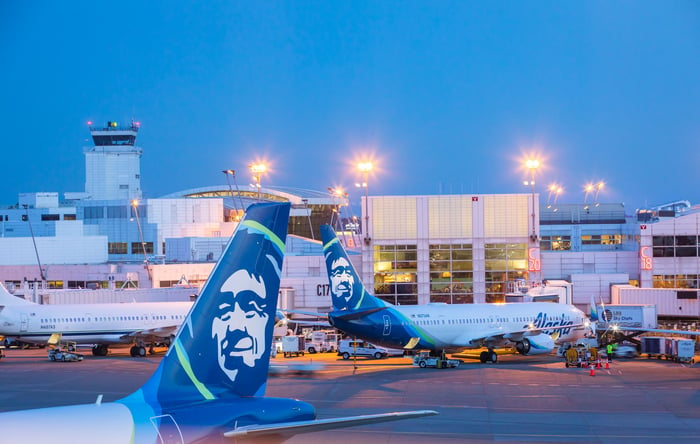When U.S. airlines released their second-quarter earnings results in July, they presented bullish outlooks for the third quarter. While U.S. COVID-19 case numbers had already begun to rise steeply by the second week of July, airlines indicated that the demand recovery that had begun in early 2021 showed no signs of slowing.
This blasé attitude lasted just a few short weeks. As more people began to recognize the increased risk of disease transmission associated with the Delta variant, booking activity slowed again and flight cancellations ticked up. This forced Southwest Airlines (LUV) to cut its third-quarter guidance last month. On Thursday, West Coast-focused airline Alaska Air (ALK 1.18%) followed suit.

Image source: Alaska Airlines.
Clear signs of another demand slump
During July, Americans' desire to reconnect with family and friends and make up for vacations canceled in 2020 kept leisure travel demand red-hot despite the Delta variant's spread. However, COVID-19 case numbers and hospitalizations exploded higher beginning in late July, making some would-be travelers more nervous about flying.
Moreover, the summer leisure travel season has been winding down for the past few weeks, as the school year has begun in many parts of the U.S. Typically, demand would shift toward more business travel around this time. However, large corporations have been especially cautious about sending employees on the road during the pandemic. The recent surge in COVID-19 cases has therefore dashed airlines' hopes of a robust business travel recovery this fall.
On the bright side, U.S. air travel demand has held up much better than during previous waves of the pandemic. Nevertheless, passenger volumes at TSA checkpoints have decreased significantly over the past three weeks, even compared to the airline industry's typical seasonality.
Alaska reduces guidance
In this context, investors shouldn't be surprised that many airlines are reducing their forecasts. In July, Alaska Airlines projected that third-quarter revenue would decrease 17% to 20% relative to 2019 on 17% to 20% less capacity. This implied that unit revenue would recover to around Q3 2019 levels, enabling Alaska to post a double-digit adjusted pre-tax margin despite facing unit cost pressure due to its capacity reductions.
In its guidance update on Thursday, Alaska noted that "bookings trends have deteriorated moderately as COVID case counts have increased." As a result, it expects its Q3 load factor -- the percentage of seats filled with paying customers -- to be several percentage points worse than it had initially estimated.

Image source: Alaska Airlines.
This will cause revenue to fall 19% to 21% compared to 2019 on 17% to 18% less capacity. Still, this leaves Alaska in position to post a solid profit and generate modestly positive operating cash flow in the third quarter.
No cause for concern here
All things considered, Alaska Airlines is weathering the recent demand slump very well. It entered the quarter planning to reduce capacity by at least 17% relative to 2019, roughly matching the change in domestic travel demand over that period. That will help it remain comfortably profitable this quarter despite demand falling short of its prior expectations.
By contrast, as of July 22, Southwest Airlines planned to fly the same amount of capacity in Q3 as it did two years earlier. The carrier has since trimmed its flight schedules, but it is still flooding the market with too much capacity relative to demand. As a result, Southwest's unit revenue is on track to plunge from pre-pandemic levels, likely leading to a third-quarter loss.
So far, Alaska Airlines has stuck to its plan to fully restore capacity to 2019 levels by next summer. That's a far more realistic timetable than the one Southwest implemented. Moreover, Alaska has ordered more jets in recent months to support a return to mid-single-digit annual growth beginning in 2023.
By 2024, Alaska should be significantly larger than its pre-pandemic size, and it will have replaced most of its least efficient planes with brand-new Boeing 737 MAX 9s, driving unit costs down. That sets the stage for a strong profit recovery over the next three years.





